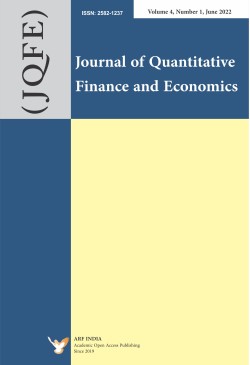
Journal of Quantitative Finance and Economics
Frequency :Bi-Annual
ISSN :2582-1237
Peer Reviewed Journal
A Multi-Level Quantitative Analysis of the Relation of Socio-Economic Factors with the Gender Ratio in India
Khyati Khandelwal (2023). A Multi-Level Quantitative Analysis of the Relation of Socio-Economic Factors with the Gender Ratio in India. Journal of Quantitative Finance and Economics. 5(1), 1-23. https://DOI:10.47509/JQFE.2023.v05i01.01
Financial Development and Economic Growth in Cameroon: An ARDL Bound Test and Multivariate Granger Causality Framework
Trade Networking and Business Cycle Synchronisation
Fumihide Takeuchi (2023). Trade Networking and Business Cycle Synchronisation. Journal of Quantitative Finance and Economics. 5(1), 49-71. https://DOI:10.47509/JQFE.2023.v05i01.03
Exuberance, Asymmetric Volatility and Connectedness in Fan Tokens
The Nature of Inflation-Growth Nexus in Tunisia: Empirical Study with ARDL Approach
Effects of Foreign Direct Investment on Total Factor Productivity in CEMAC
Impact of Shareholding Reforms of State-owned Enterprises on Environmental Pollution Prevention Policy
How Healthcare Industry can Leverage Big Data Analytics Technology and Tools for Efficient Management
Heterogeneous Impacts of Covid-19 on Youth Employment: A Study for Brazilian Regions
How are Working Hours and Wage Earnings Determined? A Theoretical and Empirical Study
JEL code: J22, J23, C13.
Tomio Kinoshita (2023). How are Working Hourse and Wage Earnings Determined? A Theoretical and Empirical Study. Journal of Quantitative Finance and Economics. 5(1), 185-200. https://DOI:10.47509/JQFE.2023.v05i01.10